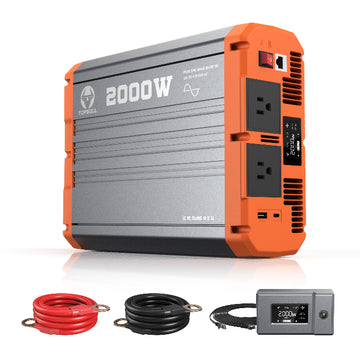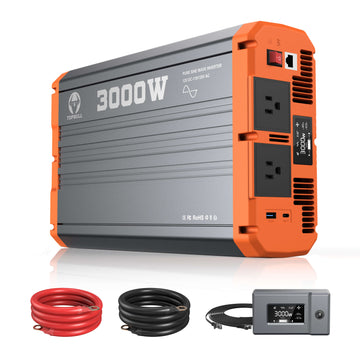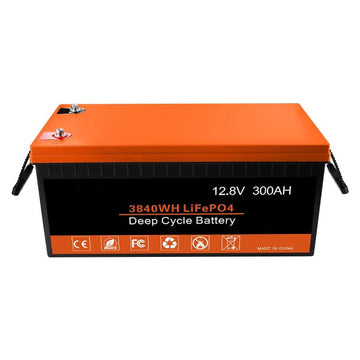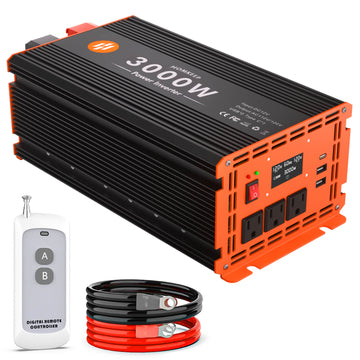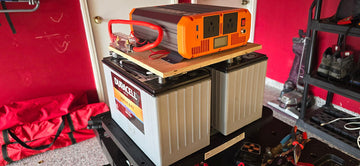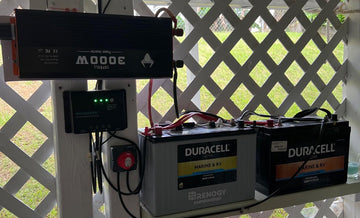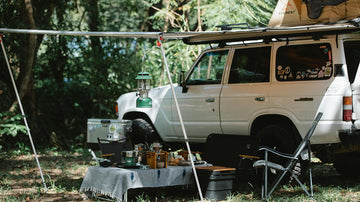If you've ever considered powering your appliances with an RV or a solar panel, you've likely encountered the challenge of converting DC (direct current) into AC (alternating current). That's exactly where a power inverter comes into play.
This guide will explain everything you need to know about inverters, including how they work, their benefits, and their various applications. Plus, if you're looking to buy one, we'll introduce some of the best inverters on the market to help you make an informed choice.
Table of contents:
- What is an Inverter and What Does A Power Inverter Do
- Types of Inverter
- Key Functions and Features of an Inverter
- A Portable Power Inverter is All You Need
- How to Choose the Right Inverter
- Best Inverters You Should Not Miss
- What is the Difference Between Inverter and Charger
- FAQs About Inverters and How They Work
- Conclusion
What is an Inverter and What Does A Power Inverter Do
An inverter is a type of power electronic device that is mainly used to convert direct current (DC) into alternating current (AC). Its working principle is based on the change of switching circuits, so that the input DC power is converted into AC power with the required frequency and voltage through the circuit. Inverters are widely used in solar power systems, automotive power supplies, backup power systems and other fields, and are the core component for power conversion and control.
In the U.S., the output voltage standard of inverters needs to follow the regulations of the U.S. power system. Most inverters for home use often need to output 12V battery DC to 120V and 110V sine wave AC, which is consistent with the U.S. power system standards (Although typically labeled as 120V in the U.S., the amplitude of the flow voltage may actually vary between 110V and 125V.).For more details, do check out our guide for how a 12V to 120V electrical inverter works
What is A Power Inverter Used for
110/120V is a common single-phase supply voltage widely used for most household appliances and equipment such as lights, stoves, microwaves and refrigerators. For RV travelers and outdoor camping enthusiasts, you often need to rely on DC power from batteries when you're in an isolated environment with no electricity or when you're moving around a lot. This is where a power inverter comes into play, converting 12V DC to 120V AC to support a variety of electrical devices.

Types of Inverter
Now that we have understood the working principle of power inverters, let's understand what types of inverters are available? For common consumer-grade inverters, they are often categorized as follows based on output waveform, application scenario, and power size:
Classified according to the output waveform:
- Pure Sine Wave Inverter: The output voltage waveform is a true sine wave, which can fully conform to the AC waveform of the standard power grid. Suitable for all types of appliances, such as household central air conditioners, microwave ovens, water heaters and other high-end appliances, computers, shavers, certain medical equipment and other sensitive equipment can also be used, pure sine wave inverter performance is the best, but the cost is higher.
- Modified Sine Wave Inverter: The output voltage waveform of Modified Sine Wave Inverter is close to a sine wave, but it can't exactly duplicate the shape of a sine wave, and usually consists of a combination of multiple square waves, which is suitable for most household equipment (such as refrigerators, washing machines, TV shows, etc.), but may affect certain sensitive equipment (such as precision electronic equipment or certain electric motors).
-
Square wave inverter: The output voltage waveform of a square wave inverter is a square wave. Square wave inverters are low-cost, but with lower efficiency and poor waveform quality, the output power may not be friendly enough for some sensitive devices, and can only be applied to some simple loads such as electric fans, incandescent lamps and some non-inductive loads such as electric hot pots. It can also be applied to some small power tools (such as drills and some low-power power tools)
Categorized according to application scenarios:
-
Home inverter: used in home solar power systems to convert DC power generated by solar panels into AC power for home use.
-
Solar Inverter: Specially designed to convert DC power generated by PV panels into AC power, including string inverters and micro inverters and other types.
-
Portable Inverter: A lightweight power inverter that is convenient for powering various appliances and devices during outdoor activities, travel or emergency situations.
Categorized by power size:
-
Small power inverter: The power range is generally between 100W and 1000W. Mostly used for portable devices, small appliances and personal electronics, suitable for outdoor activities, traveling and other occasions. Typical examples include charging cell phones, laptops, LED lights and small electric fans.
-
Medium Power Inverter: The power range is generally between 1000W and 5000W. Suitable for home or small commercial installations, capable of driving multiple household appliances. Common applications include home inverters for solar power systems and powering devices such as washing machines, refrigerators and televisions.
- High Power Inverter: The power range is typically above 5000W and can reach tens of thousands of watts. Specialized for large electrical equipment and industrial applications such as heavy machinery, central air conditioning and solar power plants. High power inverters typically require specialized installation and configuration and are suitable for commercial facilities or large residences.
Related Reading: the difference between pure sine wave inverters and modified sine wave inverters
Learn about the types and features of inverters through one article
Key Functions and Features of an Inverter
What capabilities should an inverter have? You need to understand these key functions and features of an inverter:
-
Electrical energy conversion: the most basic function of an inverter is to convert direct current (DC) to alternating current (AC). This function allows inverters to convert electricity generated by DC power sources such as solar panels or storage batteries into AC power used by household appliances and the public power grid.
Voltage regulation: Inverters ensure that the output voltage meets grid standards and maintains power stability. This is essential for protecting electrical equipment and improving the efficiency of power usage. - Grid-connected and off-grid functions: Grid-connected inverters are able to feed excess power back into the public grid for power sharing and credit capture. Off-grid inverters , on the other hand, are suitable for stand-alone scenarios, such as remote areas or emergency backup power.
- Energy monitoring and management: Modern inverters are often equipped with intelligent algorithms that track power generation, consumption and storage data in real time, helping users to understand energy usage and optimize energy efficiency.
- High Efficiency: Modern high-end inverters have conversion efficiencies of 98% or more, minimizing energy loss and increasing the efficiency of power usage.
- Safety: Inverters are equipped with multiple protection functions such as short-circuit, overload, over/under voltage, and over-temperature to ensure safe and stable operation of the equipment under abnormal conditions.
- Physical Properties: The inverter usually adopts high-quality materials such as all-aluminum shell, which has good heat dissipation and friction resistance, and can resist the extrusion or impact of certain external forces.
-
Stability and adaptability: The inverter has strong adaptability and stability with load, and can keep the output voltage and frequency stable under different load conditions.
A Portable Power Inverter is All You Need
Portable power inverters excel in a wide variety of situations, especially for emergency backup power, outdoor adventure power needs, and temporary power situations. Here are some of the most common applications and use cases of inverters.

Emergency Backup Power
In the event of a power outage or grid failure, a portable inverter can be used as an emergency backup power source to power cell phones, flashlights, laptops, small appliances, etc., ensuring that basic living and communication needs are not affected.
Outdoor activities
For people who like camping, hiking, picnics and other outdoor activities, portable inverters can be connected to car batteries or solar panels to charge cameras, drones, portable stereos and other devices, enhancing the fun and convenience of outdoor activities.
Temporary power needs
In temporary construction sites, exhibitions, events and other occasions, portable inverters can be connected to generators or high-capacity batteries to provide power support for small electrical devices.
How to Choose the Right Inverter
As mentioned, a suitable portable inverter can undoubtedly bring great convenience and peace of mind to your daily life, so how do we choose an inverter that suits your needs? There are several factors to consider when choosing the right inverter, here are some key steps and suggestions:
1. Define the needs and scenarios
-
Purpose: First of all, clarify the purpose of the inverter, whether it is used for home backup power, outdoor activities, industrial applications or other special occasions. The power, voltage and waveform quality requirements of the inverter may be different for different occasions.
-
Power requirement: Select the power of the inverter according to the total power of the power-using equipment. Make sure the output power of the inverter is greater than or equal to the total power of the required equipment, and consider a certain margin to cope with possible future expansion or unexpected situations.
- Voltage requirements: Determine the type of voltage output from the inverter and whether the stability and fluctuation range of the voltage meets the requirements of the power-using equipment.
2. Pay attention to the performance index of the inverter
-
Inverter efficiency: Inverter efficiency is an important parameter to measure the performance of the inverter. An inverter with high efficiency can better utilize the power and reduce energy loss. When choosing, you can pay attention to the efficiency value of the inverter and try to choose the product with higher efficiency.
-
Waveform quality: Choose high quality inverters, such as sine wave inverters, to ensure the normal operation and safety of power equipment. The voltage waveform output from a sine wave inverter is similar to that of the mains, which makes it more compatible with power-using equipment.
-
Output voltage stability: The inverter should have good output voltage stability to ensure that the output voltage can remain stable when the input voltage fluctuates or the load changes.
-
Protection function: Choose an inverter with safety protection functions such as overload protection, short-circuit protection, overheating protection, etc. to ensure the safety of equipment and personnel. These protection functions can automatically cut off the power supply or adjust the output when the inverter encounters abnormal conditions, preventing equipment damage or safety accidents.
- Noise level of the inverter: As an electronic device, the inverter contains internal components such as transformer, filter inductor, electromagnetic switch, fan, etc., which will generate certain noise during operation. The noise generated during normal operation of the inverter should not exceed a certain level. In general, the noise level of large inverters should not exceed 80dB(A), and the noise level of small inverters should not exceed 65dB(A).
3: Consider the added value of the inverter
When purchasing an inverter, the function of intelligent recognition of conversion voltage is a highlight, which can automatically recognize and adapt to different voltage environments (e.g., 110V or 120V) without the need to manually adjust the settings, ensuring that the equipment works properly in different countries and regions. This not only reduces the risk of equipment damage due to voltage mismatch, but also simplifies the user operation process and improves the overall experience.
In addition, the power socket and USB port configurations of the inverters vary significantly. Some basic models may be equipped with only one socket, while high-end models offer multiple sockets and a variety of USB ports, including USB-A and Type-C fast charging ports. In particular, topbull inverters are excellent in this regard, equipped with 2 US-size AC power outlets as well as USB and Type-C fast charging ports, which fully satisfy the daily power needs of general users.
4. Choose a reliable brand and model
-
Brand reputation: choose well-known brands and inverters with good reputation, these brands usually have more advanced technology and better after-sales service system, which can provide users with more reliable products and services.
- Model selection: Choose the right model according to the specific needs and scenarios. Different brands and models of inverters may differ in terms of performance, price, size, etc., so you need to consider all factors to make a choice.
5. Consider the price of the inverter
Price is a key factor that cannot be ignored when choosing an inverter. However, on the basis of budget planning, it is necessary to comprehensively consider the product's cost-effectiveness, long-term operating costs, brand reputation and after-sales service and other dimensions, so as to ensure that the selected inverter meets the economic principle as well as the performance requirements, and to maximize the long-term benefits.
It should be noted that even for the same type of inverter, the price difference between different brands is significant. In the portable inverter market, Topbull inverters stand out due to their significant price advantage. With the same power and quality, Topbull inverters are more than 30% less expensive than other brands, which allows users to get stable power supply and high quality electricity while enjoying high cost performance to meet diversified consumer needs.
For a more detailed look at choosing the right portable inverter, please read: Portable Inverter Buying Guide: The Best Choice to Ensure Your Energy Needs
Best Inverters You Should Not Miss
Choosing the right inverter can be overwhelming with so many options available. Whether you need backup power for your home, a reliable source for outdoor activities, or a high-capacity solution for heavy-duty tasks, TOPBULL inverters deliver outstanding performance, durability, and efficiency. Crafted with high-quality materials, they ensure minimal energy loss and smooth power conversion for all your needs.
Here are 3 top-rated TOPBULL pure sine wave inverters to consider.
TOPBULL 2000W Pure Sine Wave Inverter

Compact yet powerful, TOPBULL 2000W Pure Sine Wave Inverter is perfect for home backup, RVs, and camping. It reliably powers refrigerators, TVs, and small appliances, delivering clean AC power for laptops and phones without interference.
TOPBULL 3000W Pure Sine Wave Inverter

With 3000W (6000W peak), TOPBULL 3000W Pure Sine Wave Inverter handles air conditioners, power tools, and large household appliances. Its compact and durable design, along with advanced safety features, makes it ideal for camper vans, RVs, and off-grid setups.
TOPBULL 4000W Pure Sine Wave Inverter

Designed for high-power applications, TOPBULL 4000W Pure Sine Wave Inverter supports food trucks and heavy-duty vans. It ensures stable power for sensitive electronics, with a remote control and LCD for easy monitoring.
The TOPBULL range of pure sine wave inverters ensures that you have a one-stop solution to all your portable electricity needs. Try them out today to experience a whole new level of convenience.
Here are some of the key specifications for TOPBULL models that stand out from the competition:
| Feature | TOPBULL 2000W | TOPBULL 3000W | TOPBULL 4000W |
|
Best For
|
Small devices, portable power needs | Medium devices, regular home and outdoor use | High-power devices, large projects, heavy-duty applications |
| Continuous Power | 2000W | 3000W | 4000W |
| Peak Power | 4000W | 6000W | 8000W |
| Usage Scenario | RVs, camping, travel | Home, and outdoor activities | High-power applications, off-grid solar, food trucks |
| Suitable Devices | Refrigerators, TVs, small appliances, laptops, phones, etc. | Air conditioners, large household appliances | Sensitive electronics, heavy-duty tools |
| Pure Copper Cable | √ | √ | √ |
| 7-Protection Mechanism | √ | √ | √ |
| Outlets | 2 Standard US Outlets, 1 USB C, and 1 USB | 2 Standard US Outlets, 1 USB C, and 1 USB | 2 Standard US Outlets, 1 USB C, and 1 USB |
What is the Difference Between Inverter and Charger
Although both inverters and chargers involve the conversion of electrical energy, there are significant differences in their functions and uses. A charger is mainly used to convert AC power to DC power to charge batteries. An inverter, on the other hand, converts DC power to AC power to meet the power needs of various devices and systems. Simply put, the charger is "charging" electricity, while the inverter is "changing" electricity.
FAQs About Inverters and How They Work
1. How to calculate the inverter efficiency?
Inverter efficiency is the ratio of inverter output power to input power. Generally speaking, the higher the inverter efficiency, the lower the energy loss.
2. How to maintain the inverter?
Maintenance of inverter mainly includes cleaning, checking and replacing damaged parts. Regularly checking the operation status of the inverter, timely finding and solving problems can ensure the long-term stable operation of the inverter.
3.How to choose an inverter?
When choosing an inverter, you need to choose according to the specific application scenario and needs. Factors to be considered include the power of the inverter, output waveform, protection function, etc.. At the same time, you also need to choose regular brands and high-quality products to ensure the quality and performance of the inverter.
4. How long does an inverter last?
The lifespan of an inverter typically ranges from 10 to 15 years, depending on factors such as the quality of the inverter and how often it is used. Proper maintenance can also help extend its service life.
5. Can an inverter run continuously?
Yes, an inverter can run continuously, as long as it has efficient cooling systems to prevent overheating. Also, be sure to keep the power consumption of appliances connected to an inverter below the inverter's wattage capacity.
However, it's generally not recommended to keep it running all the time, as it will drain the battery and shorten its lifespan. The best practice is to turn off the inverter when not in use and only run it when needed to save battery power.
Conclusion
By now, you should have a good understanding of what inverters are, their functions, and how they can enhance your outdoor experiences. While finding a high-quality, affordable inverter can be challenging, TOPBULL simplifies the choice. With TOPBULL's reliable and top-rated inverters, you can enjoy efficient power and long-lasting performance, no matter the situation.

